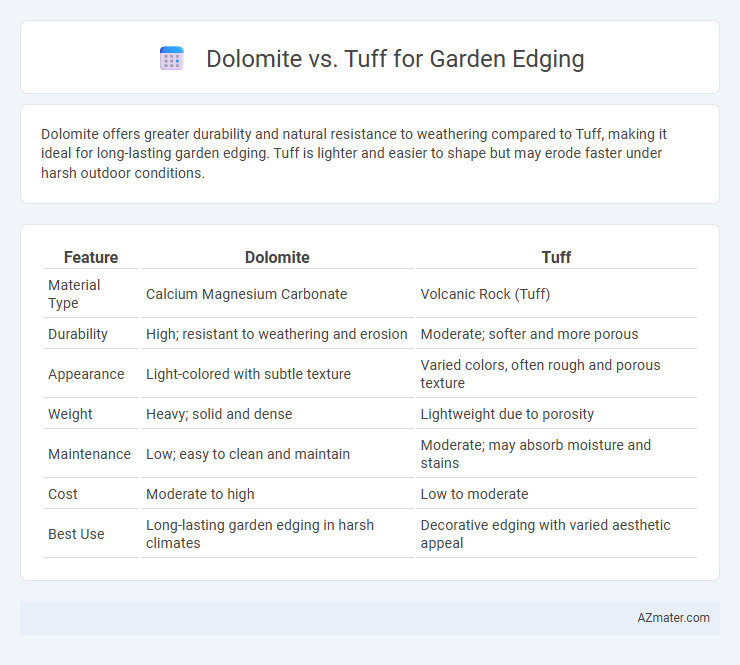Dolomite offers greater durability and natural resistance to weathering compared to Tuff, making it ideal for long-lasting garden edging. Tuff is lighter and easier to shape but may erode faster under harsh outdoor conditions.
Table of Comparison
| Feature | Dolomite | Tuff |
|---|---|---|
| Material Type | Calcium Magnesium Carbonate | Volcanic Rock (Tuff) |
| Durability | High; resistant to weathering and erosion | Moderate; softer and more porous |
| Appearance | Light-colored with subtle texture | Varied colors, often rough and porous texture |
| Weight | Heavy; solid and dense | Lightweight due to porosity |
| Maintenance | Low; easy to clean and maintain | Moderate; may absorb moisture and stains |
| Cost | Moderate to high | Low to moderate |
| Best Use | Long-lasting garden edging in harsh climates | Decorative edging with varied aesthetic appeal |
Introduction to Dolomite and Tuff
Dolomite is a durable sedimentary rock rich in calcium magnesium carbonate, often used in garden edging for its resistance to weathering and natural, earthy appearance. Tuff, a volcanic rock formed from compacted ash, offers a lightweight yet sturdy option with a porous texture that promotes drainage and adds rustic charm. Both materials provide unique aesthetic and functional benefits, making them popular choices for defining garden boundaries.
Key Differences Between Dolomite and Tuff
Dolomite is a sedimentary rock composed primarily of calcium magnesium carbonate, offering a durable and naturally resistant option for garden edging, while tuff is a soft volcanic rock made from compacted volcanic ash, known for its lightweight and porous structure. Dolomite provides higher hardness and weather resistance, making it less prone to erosion and ideal for long-lasting borders, whereas tuff's texture allows for easier cutting and shaping but may require more maintenance due to its vulnerability to weathering. The color variations also differ, with dolomite typically appearing in white to gray tones and tuff exhibiting a broader color range including earthy reds and browns, influencing aesthetic choices in garden design.
Physical Appearance and Aesthetic Appeal
Dolomite for garden edging offers a sleek, light gray to white appearance with a fine, crystalline texture that lends a clean, modern look to landscaping. Tuff showcases a more rustic, earthy palette ranging from warm browns to reddish hues, featuring a porous, rough surface that adds natural charm and visual interest. Choosing between dolomite and tuff depends on the desired garden style, with dolomite suiting contemporary designs and tuff enhancing natural, rugged aesthetics.
Durability and Weather Resistance
Dolomite offers exceptional durability for garden edging thanks to its dense, hard composition, which resists chipping and cracking under pressure. Tuff, a volcanic rock, provides strong weather resistance due to its porous yet sturdy structure, allowing it to withstand freeze-thaw cycles without significant deterioration. Both materials perform well in diverse climates, but dolomite generally excels in retaining structural integrity over long periods, making it ideal for lasting garden borders.
Ease of Installation for Garden Edging
Dolomite offers ease of installation for garden edging due to its uniform shape and lightweight properties, allowing for straightforward placement and alignment. Tuff, being more porous and irregular in shape, may require additional cutting and fitting, increasing installation time and effort. Choosing dolomite ensures quicker setup with minimal adjustments, ideal for DIY garden projects.
Cost Comparison: Dolomite vs Tuff
Dolomite garden edging typically costs between $3 to $6 per square foot, offering a durable and weather-resistant option for landscaping projects. Tuff, on the other hand, is generally more affordable, with prices ranging from $2 to $4 per square foot, making it a budget-friendly choice for garden borders. While Dolomite provides a longer lifespan and stronger structural integrity, Tuff remains a cost-effective alternative suitable for decorative edging with moderate wear.
Environmental Impact and Sustainability
Dolomite, a natural mineral mainly composed of calcium magnesium carbonate, offers high durability with minimal environmental degradation during extraction, making it a sustainable choice for garden edging due to its long lifespan and low maintenance. Tuff, a volcanic rock formed from consolidated ash, is lightweight and porous, which can promote soil health by allowing water infiltration but may have a higher environmental footprint if sourced from regions with active mining practices. Choosing dolomite supports sustainability through reduced resource extraction frequency, while tuff's biodegradability and soil benefits appeal to eco-conscious gardeners prioritizing natural ecosystem integration.
Maintenance Requirements
Dolomite garden edging requires minimal maintenance due to its dense, durable composition that resists erosion and weathering over time. Tuff, a softer volcanic rock, tends to erode faster and may need periodic repairs or replacement to maintain its shape and appearance. Regular cleaning and occasional sealing can extend the lifespan of both materials but dolomite's inherent hardness reduces the frequency of these tasks significantly.
Best Garden Styles for Each Stone
Dolomite is ideal for formal garden styles due to its clean, white or gray appearance that complements structured layouts and classic designs. Tuff, with its porous texture and earthy tones, suits rustic or Mediterranean gardens, enhancing natural, organic aesthetics and blending seamlessly with native plants. Both stones provide durable edging, but Dolomite's polished look is best for contemporary gardens, while Tuff's rugged facade fits informal, naturalistic settings.
Final Verdict: Choosing the Right Stone for Your Garden Edging
Dolomite offers superior durability and resistance to weathering, making it an ideal choice for long-lasting garden edging. Tuff provides a lighter, more porous option that promotes better drainage and adds a natural aesthetic with its varied textures. Choosing between dolomite and tuff depends on your garden's climate conditions and desired visual appeal, with dolomite suited for robust, structured borders and tuff enhancing softer, organic garden designs.

Infographic: Dolomite vs Tuff for Garden Edging
 azmater.com
azmater.com